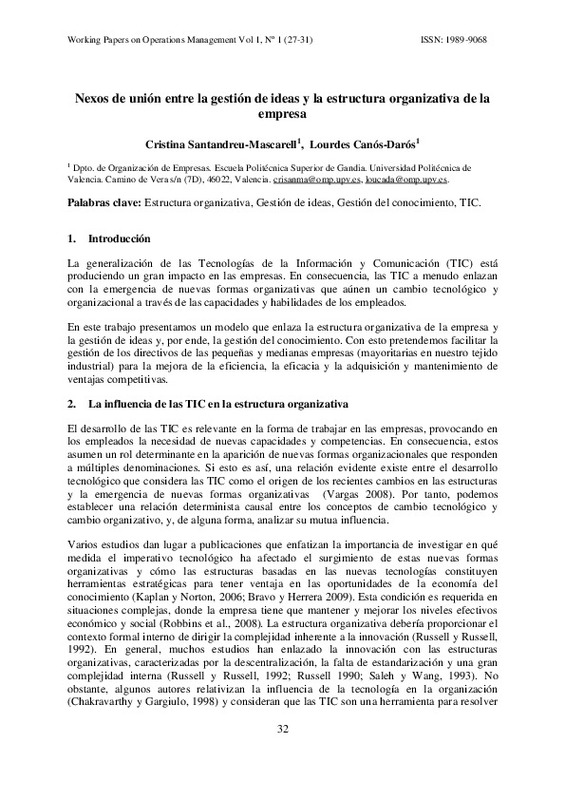Chakravarthy, B., & Gargiulo, M. (1998). Maintaining Leadership Legitimacy in the Transition to New Organizational Forms. Journal of Management Studies, 35(4), 437-456. doi:10.1111/1467-6486.00104
Chesbrough, H.; Teece, D.C., (1996). When is virtual virtuous?: Organizing for innovation. Harvard Business Review, Vol. 64, January/February, pp 65-73.
Davenport, T.H.; Eccles R.G.; Prusak, L. (1992). Information Politics. Sloan Management Review, Vol. 34, fall, pp. 53-65.
[+]
Chakravarthy, B., & Gargiulo, M. (1998). Maintaining Leadership Legitimacy in the Transition to New Organizational Forms. Journal of Management Studies, 35(4), 437-456. doi:10.1111/1467-6486.00104
Chesbrough, H.; Teece, D.C., (1996). When is virtual virtuous?: Organizing for innovation. Harvard Business Review, Vol. 64, January/February, pp 65-73.
Davenport, T.H.; Eccles R.G.; Prusak, L. (1992). Information Politics. Sloan Management Review, Vol. 34, fall, pp. 53-65.
Desreumeaux, A. (1996). Nouvelles formes d' organisation et évolution de l' enterprise. Revue Française de Gestion, Nº 107, Janvier - Fevrier, pp 86-108.
Dubrin, A.J. (2002). Fundamentals of organizational behaviour. South-Western Thomson Learning.
Galbraith, J. R. (1974). Organization Design: An Information Processing View. Interfaces, 4(3), 28-36. doi:10.1287/inte.4.3.28
Hann, J., & Weber, R. (1996). Information Systems Planning: A Model and Empirical Tests. Management Science, 42(7), 1043-1064. doi:10.1287/mnsc.42.7.1043
Jarillo, J. C. (1988). On strategic networks. Strategic Management Journal, 9(1), 31-41. doi:10.1002/smj.4250090104
Kaplan, R. S. (2006). How to implement a new strategy without disrupting your organization. Strategic Direction, 22(8). doi:10.1108/sd.2006.05622had.002
Morey, D.; Maybury, M.T; Thuraisingham, B.M., (2000). Knowledge Management. Classic and Contemporary Work. The MIT Press, Cambridge, MA Nelson, R.R. (1991). Why do firms differ and how does it matter? Strategic Management Journal, Vol. 12, winter, pp. 61-74.
Robbins S.P.; Pecento D.A.; Moon, H. (2008). Fundamentals of management: essential concepts and applications. Pretince Hall.
Rockart, J.F.; Short, J.E. (1989). Managing Organisational Interdependence. Sloan Management Review, Vol. 30, No. 2, pp. 7-17.
Russell, R. D., & Russell, C. J. (1992). An Examination of the Effects of Organizational Norms, Organizational Structure, and Environmental Uncertainty on Entrepreneurial Strategy. Journal of Management, 18(4), 639-656. doi:10.1177/014920639201800403
Russell, R.D. (1990). Innovations in Organizations: Toward an Integrated Model. Review of Business, Vol. 12, pp. 19-26.
Saleh, S. D., & Wang, C. K. (1993). The management of innovation: strategy, structure, and organizational climate. IEEE Transactions on Engineering Management, 40(1), 14-21. doi:10.1109/17.206645
Valdes-Conca,J.; Canos-Daros,L.; de Juana, S. (2008). B2E Relationships, Intranets and Competency Management. Human Resources Information Systems.
Vargas, G. E. (2008): Arquitectura del cambio organizacional: liderazgo, gestión del conocimiento e innovación tecnológica. Revista de Ingeniería, no.28, July/Dec. Bogotá.
Venkatraman, N.; Henderson, J.C. (1998). Real Strategies for Virtual Organizing. Sloan Management Review, Vol. 40, pp. 33-48.
[-]









